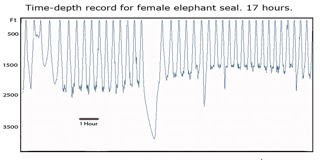The crowds thin out in June. Not the people, the seals. The beach that was covered with seals now shows plenty of sand between them. Fewer but larger, the subadult males are on the beach to molt their skin in June and July. The biggest adult males will return in July and August.
Subadult means that they are growing that distinctive elephant seal nose (technically it’s a
proboscis, a long nose), but aren’t fully mature. Their skin peels off once a year, and they spend four to six weeks on the beach looking terrible.
 |
| A six-year-old faces off with a seven-year-old |
The beach is less crowded than the crush of May, when the adult females and the juvenile seals of both sexes rested on the beach for their molt.
 | |
| There's space between seals in June |
They’ll be finding fish and squid to eat in deep waters. Wildlife habitat on land is easy to understand. It’s the woods, the plains, the fields. In the ocean, it’s not so obvious. It’s complex and three-dimensional, with zones of different temperature, density and salinity.
Tracking a seal at sea
Elephant seals’ main foraging habitat is at 1,000 feet and deeper, dark and cold. In this record of 17 hours in one day of a female elephant seal’s life, she spent most of her time around 2,000 feet. She came to the surface only briefly, for two or three minutes, to breathe, get all the oxygen she needed, and dived down again. Dives deeper than a mile have been recorded.
Most of her dives were 20 to 30 minutes. She coasted most of the way, then the jagged line indicated that she was chasing and catching prey. She came back to the surface and breathed rapidly. Her heartbeat was about 100 beats a minute at the surface, as her body flushed spent carbon dioxide and replaced it with oxygen, in her blood and muscles. Because she needs oxygen to sustain her during those long dives, her muscles have oxygen-carrying myoglobin to keep her supplied.
That accomplished, she dived back down, her heart rate slowing to about 25 beats a minute. Her blood circulation became reduced, giving priority to the brain and heart, but letting the muscles and organs rely on myoglobin.
Then there’s that one long dive, over an hour past 4,000 feet. She could have been escaping from a predator, or she could have been sleeping on the way down.
Filling in the blanks
She doesn’t need to propel herself actively downward. Seals can just coast down through the water, like a falling leaf. Seals have to sleep some time. Since they are continually diving and returning to the surface, perhaps they nap on the way down on some dives.
Exactly how she hunts isn’t yet known. Those big eyes indicate that she’s hunting by sight to some extent. When I first learned about elephant seals, that seemed odd. It’s far too dark to see anything at those depths. Light from the surface penetrates only about 650 feet. But some of her prey is bioluminescent. Those squid flash light. Her sensitive whiskers can detect slight movements and help her find prey, too.
While they are migrating, elephant seals are seldom seen by humans. They’re under water, far from human observation. Digital technology allows us to gather data and use it as a route to understanding these complicated animals, which we observe only when they are on the beach, not in the deep-water habitat where they spend most of their lives.




